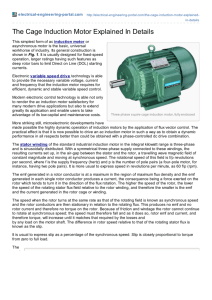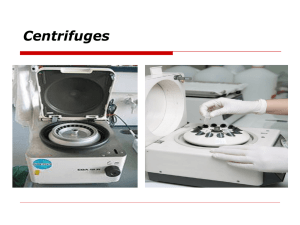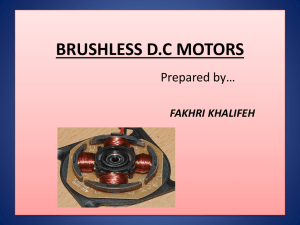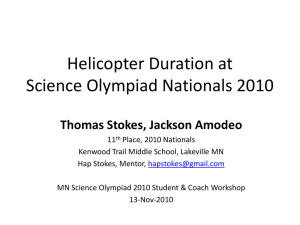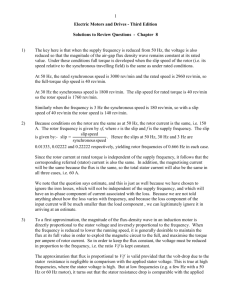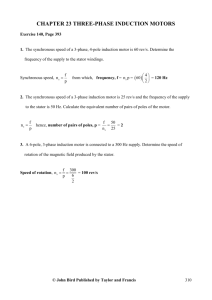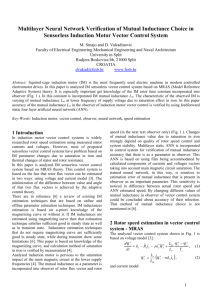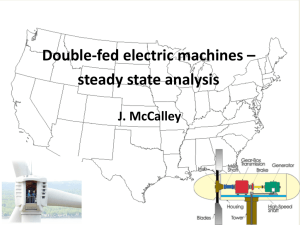Ch 4 - MyWeb at WIT
advertisement
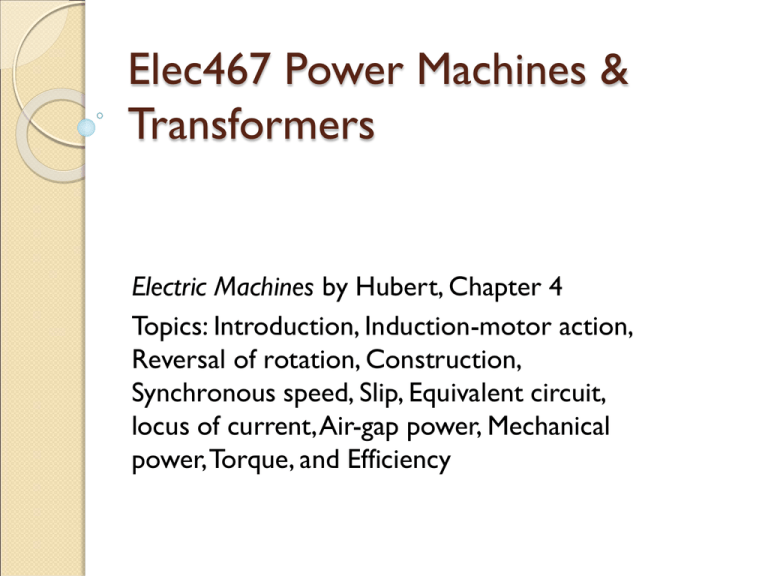
Elec467 Power Machines & Transformers Electric Machines by Hubert, Chapter 4 Topics: Introduction, Induction-motor action, Reversal of rotation, Construction, Synchronous speed, Slip, Equivalent circuit, locus of current, Air-gap power, Mechanical power, Torque, and Efficiency How is an Induction Motor wired? •On the left is the wiring for a 3-phase induction motor •On the right is the voltage graph showing the phase relationships between the different coils of the stator windings. What happens when the motor is turned on? Two flux fields are created between three points. These fields are dynamic and rotating because of the varying voltage of the line current. The flux changes direction as the fields cycle through the voltage oscillations positive to negative and back. By carefully placing the stators in 3 equal-distance locations 120 apart, the field will push and pull a metal squirrel cage around in a circle. Rotor (aka squirrel cage) The rotor is moving and crossing lines of flux thus generating a current in the rotor bars. This current creates a field around the bars and end ring of the of the squirrel cage. This field is what the stator flux lines grab ahold of to push and pull the squirrel cage in one direction. Cutaway view of a motor Examples of rotors Speed control of motor Number of poles affect placement of windings Dividing 360° by the number of poles reveal how wide an angle the winding for one of the phases can be laid over the stator. Also shown is the overlap for the next two phase windings. Synchronous Speed Synchronous speed ns is the speed of the rotating flux from the stator coil. Thus it is directly proportional to the frequency of the supply voltage, fs. It is also indirectly proportional to the number of poles, P. fs ns P2 rev/sec 120 f s ns P fs = frequency of 3Ø voltage supply ns = synchronous speed P = number of poles rev/min or rpm Slip The difference between the speed of the rotating field (ns)and the rotor speed (nr) in rpm is called slip speed, n = ns – nr The ratio of slip speed to synchronous speed is called slip, s. s = n/ns also s = (ns – nr)/ns (It’s usually a fraction or 1) Another useful formula: nr = ns(1-s) using the slip and the input voltage frequency you can calculate the rotor speed. Slip and Rotor Frequency (fr) The voltage induced in the rotor itself has a frequency. The current path for this voltage consist of the rotor bars and end connections. Pns nr Pn n=slip speed fr fr in rpm 120 120 More nifty equations with slip inserted into them: ns nr sns n sns sPn s fr 120 A test condition when the rotor can’t move is called Blocked Rotor f BR Pn s 120 f r sf BR Since s = 1 at BR … fr = fBR Rotor Voltage We’ve learned how to compute the rotor frequency, now we can use equation 1-25 to calculate the voltage across the rotor. Erms 4.44Nfmax Er 4.44Nf r max Er 4.44N (sf BR )max At BR, s = 1 Equation 1-25 Insert in rotor frequency for f Adding slip and BR data Er 4.44Nf BRmax Equivalent circuit for the rotor of an induction motor This diagram represents one stator, a 3Ø motor develops 3 times the power and torque. The rotor above is an electrically isolated closed circuit with resistive copper loss Rr and leakage reactance jXr. Also, X r 2f r Lr (4-13) Adding slip To add slip to previous slide and incorporate BR X r 2 (sf BR ) Lr s2f BR Lr X r sX BR Z r Rr jsX BR Ir sE BR Zr Ir (4-15) EBR Z r s Block Rotor equivalent circuit Rotor current I r EBR0 Z r s r X BR Rr s r tan 1 EBR r Z r s Relationship between rotor current and rotor impedance angle Can you tell where Blocked Rotor and starting current values lay? What happens when you get to synchronous speed? Locus of rotor-current phasor If you increase the load on the shaft connected to the rotor, the current phasor rotates clockwise until a value of IrcosØ° can carry the load. If we consider slip (s) the value of Ø° this graph’s lower half shows the magnitude of the rotor current and the phase angle. Another handy equation: E BR Ir sin r X BR Air-gap power Air-gap power is the power transferred across the gap between the stator and the rotor. BIG POINT: Active component Pgap is the shaft power. Including the losses due to friction, windage, and heat losses in the rotor. Considering mechanical forces Mechanical force that are part of a motor include slip, mechanical power developed, rotor power losses, shaft power out and developed torque. Mechanical Power formulas Pgap Pmech Prcl Prcl 3I Rr 2 r Pmech Where Prcl is rotor conductor losses (heat) (4-32) 3I r2 Rr (1 s ) s Pgap 3I r2 Rr s (4-34) and, Pmech Pgap 1 s (4-35) Steinmetz equivalent circuit: Rr Rr 1 s R Rr/s of Fig. 4.7(d) s (4-30) s Equivalent resistance = to mech. power r (4-36) Actual winding resistance Result of all Power formula calculations are in Watts Torque formulas Pmech 3I r2 Rr nr sns Pmech 3I r2 Rr nr 746sns Pmech TD nr 5252 21.21I r2 Rr TD sns TD 7.04Pgap ns Watts (4-37) mech. power in terms of rotor speed hp (4-38) Converts from watts to horsepower hp (4-39) inserts torque TD into formula for hp lb-ft (4-40) Converts torque into foot-pounds Here TD is a function of two variables: rotor current and slip lb-ft (4-40) Inserts Pgap into formula for lb-ft Torque speed characteristics with locus of rotor current Parasitic torques Pull-up torque of an induction motor is the minimum torque developed by the motor from rest to the speed at which breakdown occurs. This is the initial value for ideal motors seen if Fig. 4-11 or the pull-point in motors with imperfections as seen above. Parasitic torques are caused by non-sinusoidal space distribution of the rotating flux. Loss Accounting formulas Pgap = Pin – Pcore – Pscl Watts (4-44) Total power loss is: Ploss = Pscl + Pcore + Prcl + Pf,w + Pstray Theoretical diagram: Efficiency and Power Factor Useful shaft output power: Pshaft Pmech Pf ,w Pstray or Pshaft Efficiency η = Pshaft/Pin (4-49) Power Factor: FP = Pin/Sin where Sin = √(3) VlineIline Tshaft nr 5252 Example 4.6 with numbers Please open your books to page 159, break out a sheet of paper with pencil, and grab your calculators… Formulas—part 1 Formulas—part 2 Formula—part 3
